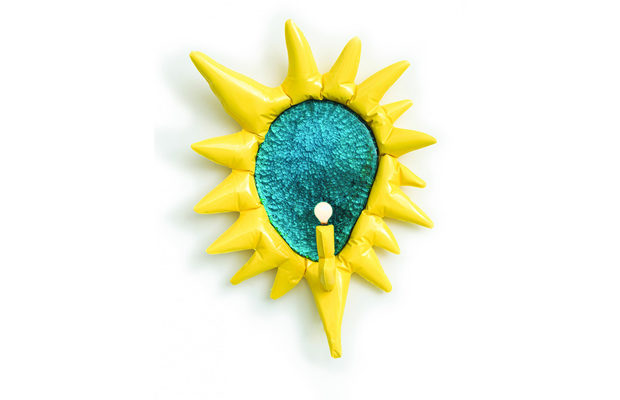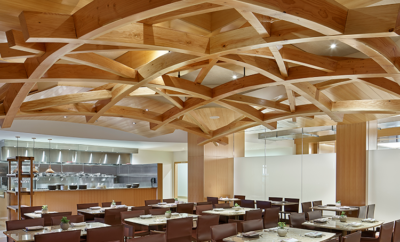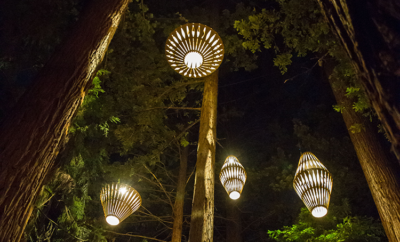 Misha Kahn’s Large Yellow Mirror/Sconce from his Saturday Morning series, 2013, is made of resin, vinyl, glass, and foil.
Misha Kahn’s Large Yellow Mirror/Sconce from his Saturday Morning series, 2013, is made of resin, vinyl, glass, and foil.
Feature
CROSSING THE BRIDGE
IN BROOKLYN’S ONCE INDUSTRIAL neighborhoods, many strung along the waterfront, a number of warehouse buildings have been converted into studio space, beckoning artists and designers to such areas as Bushwick, Red Hook, Gowanus, Sunset Park, and the Navy Yard. Three designers—Misha Kahn, Ian Stell, and Betil Dagdelen—have found a home in Brooklyn. While they toil and create on one side of the Bridge, their work has taken center stage at galleries across the East River in Manhattan.

WHEN DESIGNER BETIL DAGDELEN talks about weaving, her hands gesture emphatically as she emulates the process by which she creates her woven furniture. For a medium that can seem delicate, there is nothing dainty about her approach or the work that she produces. The streamlined silhouettes and richly patterned surfaces belie the durability and strength of her pieces. “I am not a delicate person myself. I like things that are sturdy,” Dagdelen says.
While she has mastered numerous complex patterns, Dagdelen will tell you she is not a master weaver, nor is she a maker of textiles. Weaving is but one of several facets—an important one at that—that make up the architecture of her work. On closer inspection of her Ottoman or one of her Desert Weave chairs, you notice that as one intricate pattern begins, the colors and shapes subtly shift, coalescing into a different one. It appears fluid, like an abstract canvas from an action painter—improvising within a framework. For Dagdelen, the act of weaving is a vehicle for understanding patterns, not just from an aesthetic standpoint, but how they affect our lives and shape our day-to-day.
“Weaving is mostly a repetitive pattern,” Dagdelen explains. “But, what if we introduce noise into it and just randomness? So my interest in weaving is because it is a form of art that really shows a change of a pattern, more than any other. I can weave you this whole wall in one pattern. But if there are two mistakes your eye will go right to that and disregard all the rest of it. I am trying to fight that and make people accept randomness and mistakes.”

A set of four Desert Weave dining chairs. Dagdelen often mixes yarns from different locales—including Turkey, Peru, and New Mexico—to create her weavings.
Dagdelen has a unique, if not, innovative approach to weaving. When first starting out, she used a Navajo loom made of sticks, but now constructs her own looms out of wood. She pairs her textiles with mid-century iron rod chair frames—a sleek counterpart to the weavings, allowing the patterned surfaces to stand out. In the case of her Desert Weave chairs, she found old Giandomenico Belotti frames at an auction in Santa Monica, which she later refinished. As one can imagine, sharp angles are foes to yarn’s fibers, so she seeks frames with rounded edges; because it is increasingly difficult to find the right frames, Dagdelen is starting to custom-design her own to meet her needs.
Dagdelen has called New York home for about sixteen years now. Born and raised in the coastal town of Izmir, Turkey, she went to Istanbul for university, where she studied political science. In her early twenties, she arrived in New York, and pursued an interest in production and set design. After assisting several well-known designers in the industry, she branched out on her own, working on fashion shoots, films, commercials, and music videos. “I liked doing all of it. It is the fast decision-making and sourcing and building things. I’ve always been a builder of sorts,” she says. A few years ago, she was tasked with building a set with yarn, and after the job ended, she found herself with boxes upon boxes of it piled up in her Williamsburg apartment. She considered felting the yarn, and later tried donating it without much success. So, she decided to use the leftover yarn to create a seat for a stool. With the help of YouTube, she figured out the basics, and from that point on she has been weaving. “It came so naturally. I never had anything come to me that way,” Dagdelen recalls.
Since then she has received a number of commissions for her woven furniture. Her work is represented by the Cristina Grajales Gallery in New York, and just this past year it was shown at FOG Design + Art Fair and Design Miami. She recently designed an installation for a new restaurant, Llama Inn, in Williamsburg. The project brought her to Peru where she traveled throughout the Andes and learned the techniques and traditional patterns of five different weaving communities, culminating in more than a hundred Peruvian belts that became part of the installation’s tapestry. She also created a set of three multicolored lighting fixtures for the restaurant, using traditional Peruvian back-strap weaving.
Sourcing most of her yarn from Taos, New Mexico, Peru, and her native Turkey, Dagdelen travels often. She likes mixing the yarns in a piece, even if only she notices. “It gives it this rich heritage,” she says. These days, Dagdelen splits her time between Joshua Tree, California, and Brooklyn. In her cabin out west, she spends time writing, drawing, and exploring new pattern studies; and back east, in her Red Hook studio, she creates much of her work, from hand-painted studies laden with colorful, geometric patterns to the woven daybed she is conceiving for a client in the Rockaways. These travels from coast to coast, and abroad, fuel Dagdelen: the changing landscapes are part of the fabric of her work—and like her weavings, they are a welcomed detour, a break from routine, the start of a new pattern.












